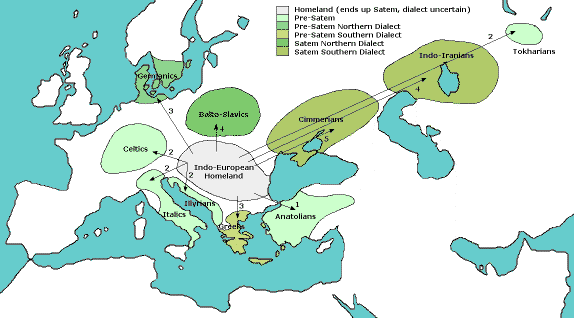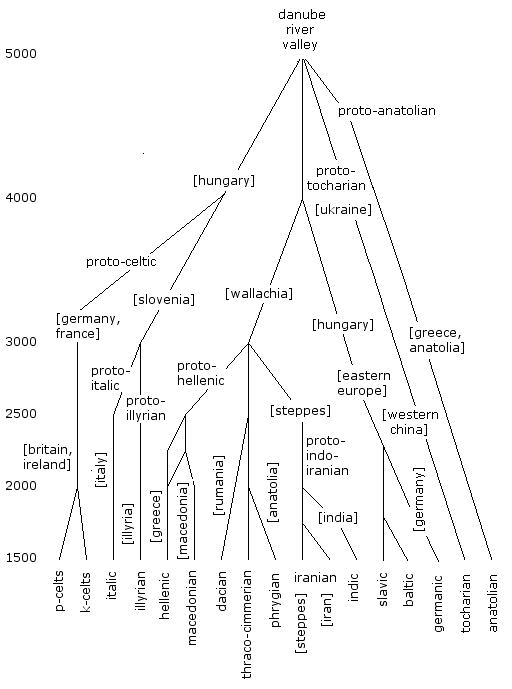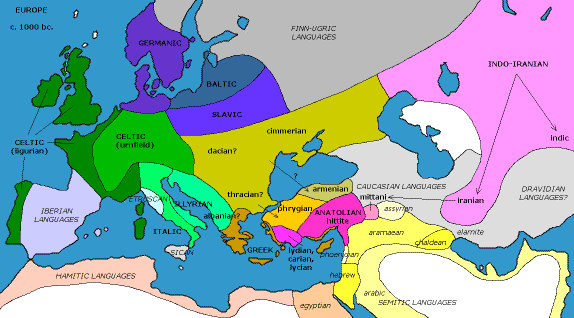Analyses seem to show that Hittite and Tokharian split from the mainstream earliest. Later, the Celtic and Italic languages split off, followed by Greek and proto-Armenian. Albanian also splits off somewhere in the same time frame. Finally, we have the Indo-Iranian languages splitting off from the central mass of Indo-European, which in turn differentiates into Germanic and Balto-Slavic.
Lexicon analysis generally supports the morphemic hypotheses, and is not too contrary to the phonetic hypotheses.
A sticking point is the place of Germanic: It seems to be both clearly tied to Baltic, yet phonetically quite distinct. It is, in fact, quite distinct from all its relations! One theory is that its similarity to Baltic is in part due to close proximity and continued contact, and that its phonetic distinctiveness is due to a pre-Germanic substrate of megalithic people sometimes referred to as "the Folk."
It is possible that pre-Indo-European neolithic people in France and England likewise influenced the development of the Celtic languages as well -- another "Folk" perhaps. The neolithic people of the Iberian peninsula and southwestern France -- including the ancestors of the modern Basques -- do not appear to have had too significant an effect on the Celtic of that area, nor on the later Latin.
Other languages have had more obvious contact with other language substrates. The Hittites and other Anatolians clearly came into an area already well-populated with non-Indo-Europeans, which no doubt hastened the rather dramatic phonetic and morphemic simplifications characteristic of those languages.
The Mycenaean Greeks may have been influenced by an Anatolian substrate in Greece and the islands (the Pelasgians?), further complicated by a second wave of Greeks (Dorians).
The Armenians appear to be closest to the Indo-Iranians in phonetic and morphemic structure, and were possibly influenced by centuries of contact with them as well as the Hittites, Semites, and Caucasians.
An Evolutionary Time-line of the Indo-European Languages
c. 5000 bc.
Homeland: The Danube River valley (Wallachia and Hungary). Farming learned from the people of Asia Minor. Cultivation of native rye and oats and domestication of native pigs, geese, and cattle begins. Strong tribal sociey develops. There are many reasons for choosing the Danube River valley: Farming is possible, although the land is less than desirable to more powerful tribes from the south; the flora and fauna of the valley, as well as for other natural features such as hills and rivers, are represented by the oldest words we can reconstruct; the natural ranges of wild horses (what would become the Indo-European's ace card) are nearby in the Ukraine; the area is central to the eventual expanse of the Indo-Europeans, with due allowance for the more rapid expanse commonplace over steppe-lands; the area is also in close proximity to some of the most conservative recent representatives of the family.
The most compelling reason is the presence of the Danubian culture, with its linear incised pottery, at this same time. The culture spreads soon after in exactly the directions that would account for the spread of PIE.
There are, of course, many other possibilities. The most common suggestion is the steppes north of the Black Sea, for many similar reasons. I believe that the strong tribal social structure suggests that the Indo-Europeans were farmers before they were pastoralists. It is highly unlikely that they went straight from steppe hunter-gatherers to sophisticated pastoralists in one step.
c. 4000 bc.
Proto-Anatolians move southeast to Thrace. They would be profoundly influenced by the advanced cultures of Asia Minor and beyond. Proto-Tokharians move east into the Ukraine. These people are the most likely originators of the horse culture. There is also plenty of evidence of ox-drawn wagons with disk wheels in the western steppes.
A western dialect begins to emerge (the Proto-Celtic-Italic-Illyrians) on the upper Danube. The enclosed steppe of the Hungarian Plain puts them in an ideal position to blend farming with a horse culture.
c. 3000 bc.
Copper working, learned from the people of Asia Minor, begins in Thrace and the Danube valley and reaches Germany by 3000 bc. Domestication of the horse spreads from the Ukraine. Within a thousand years, horsemanship spreads from the Ukraine throughout the Indo-European area, even into Scandinavia. It is the steppe inhabitants who change most dramatically into true pastoral societies. In the more wooded areas of Europe, horse ownership begins to differentiate a warrior nobility from commoners. Of course, use of the horse spreads to the non-IE societies of the Middle East as well.
The disk-wheel wagon has spread from Russia across Europe to Holland.
The Proto-Anatolians move from Thrace into Greece and Asia Minor. It is likely that they constitute the pre-Greek Pelasgian and Cretan populations (Early Aegean culture). The Proto-Tokharians continue east to the steppes, towards the Tarim Basin in northwestern China. They may be the people known to the Chinese as the Yüeh-chi, and may have been the core of the Kushan Empire of the first century AD.
The Proto-Celts separate from the rest of the western dialect and expand west into southern Germany, where they develop the Michelsburg culture. The remaining western dialect tribes edge into the modern Slovenia-Croatia area.
The main body of Indo-Europeans expands into Thrace, the Ukraine, Bohemia, and Poland, and begins to differentiate into a northern dialect (Bohemia, Poland, and Hungary, represented by the Funnel Beaker culture) and a southern dialect (Wallachia, Thrace, and Ukraine, continuing the Danubian culture).
c. 2500 bc.
Bronze working develops throughout Indo-European area.
The Proto-Italics, who speak a western dialect, move west from the Slovenia area into Italy. The Proto-Illyrians, speaking another western dialect (perhaps), move south from the northern Croatia area into Illyria (the Dalmatian coast).
One branch of the southern dialect -- Proto-Hellenic -- moves south into Macedonia, Greece, and the Aegean islands. By 1500 bc, the southern-most tribes would establish the Mycenaean culture.
A branch of the northern dialect -- Proto-Germanics -- moves northeast from Poland or Bohemia into northern Germany and Scandinavia.
The remaining main body of Indo-Europeans (the Baltic, Poland, Bohemia, the Hungarian Plain, Wallachia, Thrace, the Ukraine and the neighboring steppes) -- both northern and southern dialects -- undergoes the Satem phonetic changes.
The horse-drawn, two-wheeled chariot, with spoked wheels, is developed in the western steppes, and spreads quickly to the Balkans as well as the Middle East. A branch of the southern Satem dialect -- Proto-Indo-Iranian -- expands from Ukraine and the steppes into Afghanistan, Iran, and northwestern India. One tribe -- the Mittani -- goes as far west as northern Mesopotamia.
The main body of the southern Satem dialect expands into the Ukraine to become the Cimmerians, leaving the Dacians in the original homeland. I suspect that the Dacians were a southern (Cimmerian-like) dialect. The people of Thrace were probably closely related to the Cimmerians, with a southern Satem dialect. These people develop the steppe version of the Battle Ax culture.
The main body of the northern Satem dialect -- Proto-Balto-Slavic -- expands north from Poland into Belarus and the Baltic coast. With the Germans, they consititute the northern version of the Battle Ax culture.
The Celts expand into France and, in a retrograde move, back into Hungary. A powerful society, they pressure the original peoples of western Europe, as well as their own relations to the east. They develop the Bell-beaker culture and, later, the Urnfield culture.
Anatolians (most notably the Hittites) establish themselves in Asia Minor, where they become a major power. Their languages are profoundly affected by neighboring non-IE languages.
A second wave of Hellenics (Doric Greeks) moves into Greece from Macedonia.
c. 1500 bc.
Proto-Phrygians -- possibly a branch of the Cimmerians -- move from Thrace across the Bosporus to northwestern Asia Minor. The Phrygians would move into the power gap left by the collapse of the Hittite Empire around 1200 bc. Proto-Armenians -- possibly another branch of the Cimmerians -- move into Asia Minor, probably by means of the Bosporus. It is possible that they entered from the east coast of the Black Sea, or even across the Black Sea. In the next 1000 years, they spread over much of northern Asia Minor, but are eventually pressured into the Lake Van region.
Albanian may be the sole survivor of the Illyrian languages, its many variant features due to long contact with a variety of neighbors. Or it could be the lone descendent of a Dacian dialect that later moved into the Albanian region. I lean toward the latter, but it is very difficult to tell! So little of Dacian, Thracian, Illyrian, etc. is left to Albanians.
The Ligurian (western) Celts expand into western Iberia and the British Isles, where they absorb most of the prior inhabitants. The original inhabitants of Spain survive well into the Roman era, while the original inhabitants of southwest France survive to the present as the Basques.
The Balto-Slavics differentiate into Baltic and Slavic. Both begin to expand east- and northward, at the expense of the hunter-gatherer Finno-Ugric people.
The Indo-Iranians differentiate into Indic and Iranian. The Indic group rapidly expands across northern India as far as Magatha. The Iranians split into powerful tribes, notably the Persians and the Medes, by the 800's bc. The Iranians remaining in the steppes would come to be known as the Scyths and Sakas. The Scyths expand westward at the expense of the remaining Cimmerians.
c. 1000 bc.
Iron working begins in the Balkans by 1000 bc. It reaches Britain by 800 bc.
The "Age of Empires" begins in earnest.




